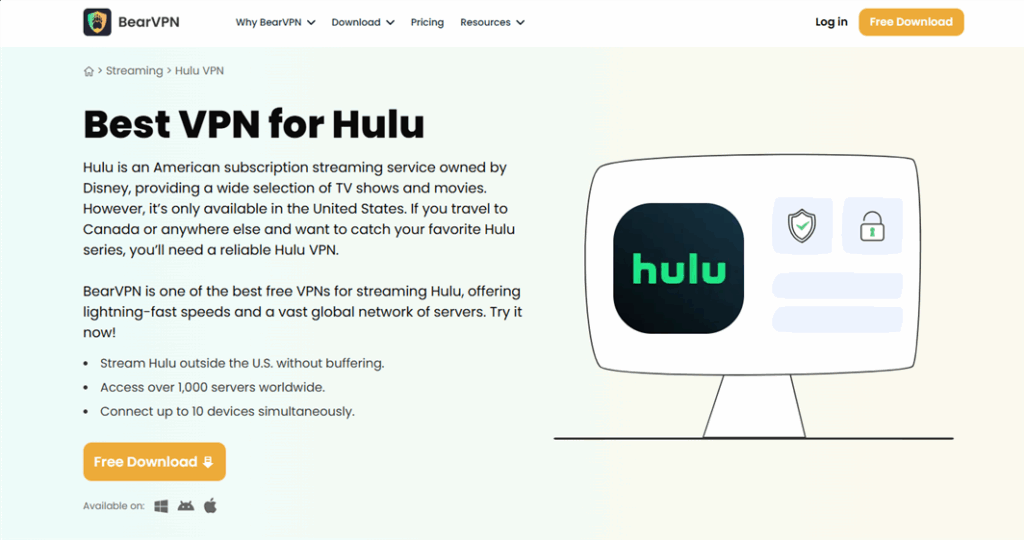You’ve connected your VPN, selected a U.S. server, and opened Hulu—only to see the message “You appear to be using an anonymous proxy tool.” It’s one of the most common frustrations for streaming users around the world.
This happens because Hulu, like most streaming services, restricts access to specific regions. When its systems detect VPN traffic, the connection is often blocked automatically. The result: a screen that stops you from watching, even when your VPN is technically working.
This guide examines why Hulu detects VPNs, what the common errors mean, and how to troubleshoot the issue without breaching Hulu’s policies or using unsafe methods. Whether you’re traveling, troubleshooting, or simply curious about how these systems work, this article aims to provide a clear, fact-based overview.
Why Hulu Blocks VPNs
Hulu’s library of shows and movies is licensed for streaming primarily in the United States. To comply with distribution agreements, Hulu uses geo-blocking, a technology that limits access based on a viewer’s location. VPNs can obscure location data, so Hulu employs detection systems to identify and restrict those connections.
Here’s how that detection works in practice:
IP Address and Server Reputation
Most VPNs route multiple users through shared IP addresses. When hundreds of connections originate from the same address, Hulu’s systems can flag it as non-residential. These IPs are then added to a blacklist.
DNS and WebRTC Leaks
Even if you connect via VPN, your device might still send DNS requests (the website lookups that map domain names to IPs) outside the encrypted tunnel. This exposes your actual location. WebRTC, a communication feature in browsers, can also leak real IP data unless disabled.
GPS and Time Zone Mismatch
Modern apps compare your device’s time zone and GPS data with your apparent IP address. A mismatch—such as a GPS signal from Toronto and an IP from Los Angeles—alerts Hulu’s systems.

Cookies and Cached Data
Old cookies can reveal your previous location or session ID. Hulu may detect inconsistencies between those cookies and your current VPN connection.
Protocol Signatures
Each VPN protocol (OpenVPN, WireGuard, etc.) has a distinct traffic signature. Hulu can sometimes identify these patterns through Deep Packet Inspection (DPI).
In short, Hulu’s VPN detection is multilayered. Even reputable VPNs sometimes get caught in the filter because detection techniques evolve constantly.
Common Hulu VPN Error Messages and What They Mean
Hulu displays a few recurring error messages when its systems detect VPN or proxy use. Recognizing them helps you pinpoint the problem faster.
| Error Message | Likely Cause | Interpretation |
| “You appear to be using an anonymous proxy tool.” (Error BYA-403-011) | VPN or proxy detected | Hulu identified your IP as part of a VPN network. |
| “Hulu is not available in your region.” | Non-U.S. IP address | The IP is outside Hulu’s service area. |
| “Error Code P-EDU101.” | Restricted account access | Sometimes appears when location validation fails. |
| “Content not available in your location.” | Geo-restriction enforcement | Hulu’s servers confirmed a mismatch between IP and content region. |
If you see any of these messages, the following troubleshooting steps can often resolve the issue.
Step-by-Step Troubleshooting: Fixing Hulu VPN Issues
If Hulu stops working when your VPN is on, there are several possible causes — from simple configuration conflicts to IP address blacklisting. The key is to troubleshoot systematically instead of switching tools blindly.
Below are 12 detailed steps to help you fix Hulu VPN issues, each explaining not just what to do, but also why it works and how to check your progress.
1. Switch to a Different U.S. Server
The simplest and most effective first step is to change to another U.S. server in your VPN application. VPN providers often maintain servers in multiple American cities such as Los Angeles, Chicago, and New York.

If too many users share the same server or its IP range becomes publicly identified as belonging to a VPN network, Hulu adds it to a blocklist.
By connecting to a different server, you obtain a fresh IP address that may not yet be flagged.
After switching, confirm that your new IP address still shows a U.S. location using tools like whatismyipaddress.com, and then reopen Hulu in a private or incognito window to test streaming.
If several servers fail in succession, it likely means that the VPN’s entire subnet has been blacklisted. In that case, you’ll need to wait until the provider rotates or refreshes its IP pool.
2. Clear Cookies, Cache, and Local Storage
Browsers and apps store session data such as previous IP addresses, login tokens, and regional identifiers.
When this stored information contradicts your current VPN IP, Hulu detects an inconsistency and may show an anonymous proxy warning.
Clearing cookies and cache resets this data and forces Hulu to re-verify your session.
For mobile or smart-TV apps, open the system settings, find the Hulu app, and clear its local storage to remove residual location data.
3. Enable DNS and WebRTC Leak Protection
Even if a VPN is active, DNS requests (the background lookups that convert domain names into IPs) can sometimes bypass the encrypted tunnel and reach your internet service provider directly.
Similarly, WebRTC — a browser feature used for real-time communication — can expose your true IP address.
Most modern VPNs include “DNS Leak Protection” or “WebRTC Blocking” options. Make sure they’re enabled.
To check, visit dnsleaktest.com or ipleak.net while connected. If your ISP’s DNS servers still appear, your VPN is leaking data, which allows Hulu to identify your actual location. Switch to a secure DNS such as Cloudflare (1.1.1.1) or Google (8.8.8.8) if your VPN allows manual configuration.
4. Disable IPv6
Many VPNs only tunnel IPv4 traffic, leaving IPv6 unprotected. This means your device could still send IPv6 packets directly through your local network, revealing your true location. Turning off IPv6 eliminates that vulnerability.
- In Windows, go to Network Connections, right-click your active connection, choose Properties, and uncheck “Internet Protocol Version 6 (TCP/IPv6).”
- On macOS, open System Settings → Network → Advanced → TCP/IP and set IPv6 configuration to Off.
Afterward, verify at test-ipv6.com that your IPv6 address is no longer visible.
5. Restart the Router and Device
Routers and modems often cache DNS information and route data. Restarting them, along with your computer or streaming device, forces a complete network refresh and clears any cached paths.
This ensures that your system connects through the VPN’s DNS instead of your ISP’s.
If your router supports manual DNS configuration, confirm that it isn’t forcing your provider’s DNS, as that can override the VPN tunnel.
6. Update the VPN Application
Running an outdated VPN client is a common cause of Hulu connection failures.
Updates frequently include new server lists, improved encryption, and refreshed IP ranges.
Older versions might rely on deprecated tunneling methods that Hulu has already flagged.
Check your VPN’s website or app settings to confirm the last update date and install the newest version available.
7. Change the VPN Protocol
Different tunneling protocols transmit data differently, and Hulu’s detection system can sometimes identify them based on packet patterns.
If you’re using WireGuard for speed, try switching to OpenVPN TCP mode — it transmits traffic in a way that closely resembles normal HTTPS communication and is less likely to be flagged.
Other options include IKEv2/IPSec or proprietary “stealth” or “obfuscated” modes if your VPN supports them.
Protocol switching can make the difference between constant blocking and consistent access.
8. Flush the DNS Cache
Operating systems keep temporary DNS records that may direct Hulu traffic through old, non-VPN routes. Flushing this cache forces your computer to request fresh DNS lookups.
Use the following commands:
- Windows:ipconfig /flushdns
- macOS:sudo killall -HUP mDNSResponder
- Linux:sudo systemd-resolve –flush-caches
Once done, reconnect to your VPN and test Hulu again.
9. Disable Browser Extensions and Extra Proxies
Browser add-ons such as ad blockers, tracker filters, or “free proxy” extensions can interfere with VPN routing or modify request headers.
These inconsistencies may lead Hulu to treat the connection as suspicious. Try disabling all extensions temporarily or launching Hulu in an incognito window, which loads the browser with no add-ons enabled.
If the problem disappears, re-enable extensions one by one to identify the culprit.
10. Reinstall or Reset the Hulu App
For users streaming via the Hulu mobile or TV app, reinstalling can help.
App store configuration data and cached credentials may not match your new VPN connection.
Uninstalling and reinstalling resets these tokens and forces Hulu to perform a fresh verification of your network environment.

Before reinstalling, log out of all devices under your Hulu account to ensure a full session reset.
11. Test on a Different Device or Network
If possible, try Hulu on another device — for example, from your smartphone instead of your laptop — or switch to a different Wi-Fi network.
This helps determine whether the issue is local (cached data, misconfiguration) or network-level (ISP routing, blocked ports).
If Hulu works on another device, the problem lies within the original device’s software or settings; if it fails everywhere, the VPN’s IP range is likely the cause.
12. Contact the VPN Provider’s Support Team
If all previous steps fail, the issue may be outside your control. Reach out to your VPN provider’s support service and ask if they have specific servers that currently work with Hulu.
Some providers maintain internal “streaming-optimized” lists or can suggest manual configuration files for OpenVPN or WireGuard.
You can also ask whether Hulu recently updated its blocklist or whether your account requires enabling an obfuscation or stealth feature.
If support confirms that no servers currently work with Hulu, it’s best to wait until their network team refreshes IP ranges.
Quick Reference Table
| Issue | Likely Cause | Recommended Fix | Verification |
| “Anonymous proxy tool” error | IP range blacklisted | Switch to a new server | Check IP geolocation |
| Region mismatch | DNS or cookie leak | Clear data / enable DNS protection | Test via dnsleaktest.com |
| Constant buffering | Bandwidth or latency issues | Change server or protocol | Run speed test |
| VPN disconnects | IPv6 or system conflict | Disable IPv6 / update app | Visit test-ipv6.com |
| App login errors | Cached session data | Reinstall Hulu app | Sign in again after clearing cache |
How BearVPN Beats Typical Hulu Blocking
Hulu uses advanced VPN detection methods — from IP reputation checks to DNS and traffic pattern analysis. While most VPNs simply add new servers after being blocked, BearVPN is built with multiple protective layers that minimize detection and ensure smoother streaming across Windows, iOS, and Android devices.
With 2,000+ servers in 50+ global locations, BearVPN provides fast and reliable access for Hulu viewers anywhere in the world.

- Dynamic IP Rotation
BearVPN continuously refreshes and distributes its U.S. IP pools. This rotation minimizes the risk of IP ranges being overloaded or blacklisted, keeping Hulu connections stable and consistent across regions.
- Built-in Leak Protection
DNS and IPv6 leaks are common reasons Hulu detects VPN users. BearVPN automatically encrypts DNS queries and disables unprotected IPv6 routes, ensuring your real location stays completely hidden throughout your streaming session.
- Smart Routing and Split Tunneling
BearVPN allows users to route only Hulu’s traffic through the VPN while keeping other apps on a normal network path. This preserves bandwidth and prevents slowdowns, especially on mobile devices.
- Adaptive Encryption and Obfuscation
To prevent traffic fingerprinting, BearVPN uses adaptive encryption and port randomization, making your VPN traffic appear like regular HTTPS data — a key advantage over standard VPNs.
- Real-Time IP Monitoring
BearVPN actively monitors IP reputation and quickly replaces blocked servers, minimizing downtime and keeping Hulu access reliable.
In short, BearVPN combines rotating IPs, leak prevention, intelligent routing, and adaptive encryption to maintain stable, private access to Hulu. While no VPN can guarantee a permanent bypass, BearVPN is engineered for resilience, transparency, and smoother streaming than typical VPNs.
Legal and Ethical Considerations
It’s important to distinguish between technical feasibility and policy compliance.
- Legal Use of VPNs: In most countries, using a VPN is entirely legal for online privacy and data security.
- Terms of Service (ToS): Hulu’s ToS generally prohibits using VPNs or proxies to mask location for accessing region-restricted content. Violating these terms may result in temporary access issues, but it is not a criminal offense.
- Ethical Considerations: Content licensing supports creators and regional distributors. Understanding and respecting these agreements helps maintain a sustainable media ecosystem.
Readers should use VPNs responsibly—mainly for security, privacy, or lawful travel-related access—not to intentionally bypass contractual restrictions.
Frequently Asked Questions
Is it legal to watch Hulu through a VPN?
Using a VPN is legal in most jurisdictions. However, accessing Hulu from outside licensed regions may violate its Terms of Service. Hulu retains the right to restrict or terminate access, but this does not typically carry legal penalties.
Why does Hulu block even premium VPNs?
Hulu’s agreements with studios require strict geo-enforcement. Even reputable VPNs route traffic through shared data-center IPs, which Hulu flags as non-residential.
Does clearing cookies really help?
Yes. Hulu often stores geographic data in cookies. Clearing them removes conflicting session information that may reveal your actual location.
Why do some VPNs still work?
Some providers refresh IP addresses frequently or use obfuscation techniques that make VPN traffic appear ordinary. These solutions aren’t guaranteed, but can temporarily succeed until detection systems update.
Can SmartDNS replace a VPN for Hulu?
SmartDNS can reroute location data without encrypting traffic. While sometimes effective, it doesn’t provide privacy protection and may expose users to data interception.
Conclusion
When Hulu stops working with your VPN, the cause usually isn’t mysterious. It’s the outcome of sophisticated geo-filtering systems that check IP addresses, DNS records, and device data.
VPNs remain valuable tools for online security and encrypted browsing, but they are not guaranteed access keys for restricted streaming services. Approaching the issue with technical understanding and ethical awareness leads to a smoother—and more responsible—viewing experience.



